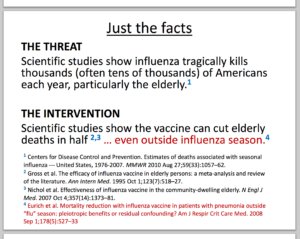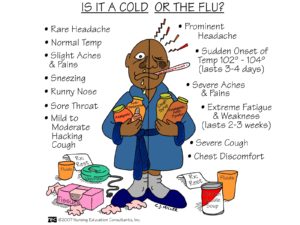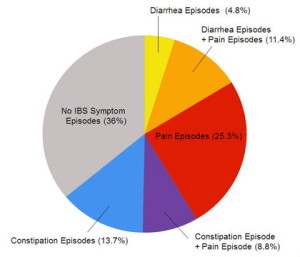Archive | January 2018
Part III Know all the facts about the FLU, that’s on the rise!
FLU FACTS:
-Both colds and flu usually last the same seven to 10 days, but flu can go three to four weeks; the flu virus may not still be there, but you have symptoms long after it has left. Allergy can last weeks or months.
-The winter flu epidemic is again around us full force and in a given locality it reaches its peak in 2 to 3 weeks and lasts 5 to 6 weeks. Then is disappears as quickly as it arrived. The reason for this is not completely clear. The usual pattern is for a rise in the incidence of flu in children, which precedes an increase in the adult population (that is on the rise in our hospitals).
-The flu virus can lead to serious complications, including bronchitis, viral or bacterial pneumonia and even death in elderly and chronically ill patients. Twenty thousand or more people die of the flu in the America each year. Know this that the frequency of human contact across the world and the highly infectious nature of the virus make this explanation difficult to accept. Moreover there is no evidence of persistent or latent infection with influenza viruses. In any case, this idea is not really very difficult from the notion that the virus circulates at a low level throughout the year and seizes its opportunity to cause an outbreak when conditions allow.
-Even harder to explain is why the flu disappears from a community when there are still a large number of people susceptible to infection. Than even harder than that is why flu is a winter disease, which is not fully understood or known. However, flu is spread largely by droplet (aerosol) infection from individuals with high viral level in their nasal and throat secretions, sneezing, and coughing on anyone close at hand. The aerosol droplets of the right size (thought to be about 1.5 micrometers in diameter) remain airborne and are breathed into the nose or lungs of the next victim. This is why the pt. stays confined in a isolation room in a hospital on droplet isolation.
-Situations in which people are crowded together are more commonly in cold or wet weather and so perhaps this contributes to spreading the flu at these times. It is interesting that in equatorial countries, flu occurs throughout the year, but is highest in the monsoon or rainy season. Enough about facts but onto logical thinking for when we or someone we know has it and what questions we might be asking ourselves.
Don’t forget so you understand if your in a hospital in the ER and than put on a unit in an droplet/contact isolation room (a room where staff and visitors wear masks, gowns and gloves with you not allowed out of that room; the reason for this is you may be able to pass on the flu to someone else. Know you can pass on the flu even before you know you are sick, as well as while you are sick. Although people with the flu are most contagious in the first 3-4 days after their illness begins, some otherwise healthy adults may be able to infect others beginning 1 day before symptoms develop and up to 5 to 7 days after becoming sick. Some people, especially young children and people with weakened immune systems, might be able to infect others with flu viruses for an even longer time.
The first and most important step in preventing flu is to get a flu vaccination each year. CDC also recommends everyday preventive actions (like staying away from people who are sick, covering coughs and sneezes and frequent handwashing) to help slow the spread of germs that cause respiratory (nose, throat, and lungs) illnesses, like flu.
It is very difficult to distinguish the flu from other viral or bacterial causes of respiratory illnesses on the basis of symptoms alone. There are tests available to diagnose flu.
A number of flu tests are available to detect influenza viruses in respiratory specimens. The most common are called “rapid influenza diagnostic tests (RIDTs).” RIDTs work by detecting the parts of the virus (antigens) that stimulate an immune response. These tests can provide results within approximately 10-15 minutes, but are not as accurate as other flu tests. Therefore, you could still have the flu, even though your rapid test result is negative. Other flu tests are called “rapid molecular assays” that detect genetic material of the virus. Rapid molecular assays produce results in 15-20 minutes and are more accurate than RIDTs. In addition, there are several more-accurate and sensitive flu tests available that must be performed in specialized laboratories, such as those found in hospitals or state public health laboratories. All of these tests require that a health care provider swipe the inside of your nose or the back of your throat with a swab and then send the swab for testing. Results may take one hour or several hours.
How well can rapid tests detect the flu?
During an influenza outbreak, a positive rapid flu test is likely to indicate influenza infection. However, rapid tests vary in their ability to detect flu viruses, depending on the type of rapid test used, and on the type of flu viruses circulating. Also, rapid tests appear to be better at detecting flu in children than adults. This variation in ability to detect viruses can result in some people who are infected with the flu having a negative rapid test result. (This situation is called a false negative test result.) Despite a negative rapid test result, your health care provider may diagnose you with flu based on your symptoms and their clinical judgment.
Now you know what the flu is from Part I, in Part II you know the treat- ments, the strategies and the best prevention of the flu and lastly today in Part III the facts on the flu! Remember its on a up rise now so do all you can in preventing it for your health!
QUOTE FOR TUESDAY:
“Recommended is that just about everyone get the flu shot: kids 6 months to 19 years of age, pregnant women, people 50 and up, and people of any age with compromised immune systems. The shot (vaccine) is beneficial.”
The U.S. Centers for Disease Control and Prevention (CDC)
QUOTE FOR MONDAY:
“Since the holidays an explosion in influenza (FLU) throughout the country. Right now, as hospitals nationwide are “bulging” with influenza patients, the patients most typically sweating it out in backed-up waiting rooms are over 65. This group, he says, is hardest hit by the season’s more severe prevailing strain; they tend to develop the most serious complications of the respiratory virus, including pneumonia. ”
William Schaffner, M.D., an infectious disease expert and member of the CDC’s national surveillance team.
Know how YOU can prevent the FLU with it on the uprise in Hospitals now!
LET’S FIGHT THE WINTER BUGS. HOW CONTAGIOUS ARE THESE BUGS & WHAT ARE THEIR SYMPTOMS.
People infected with an influenza or cold virus become contagious 24 hours after the virus enters the body (often before symptoms appear). Adults remain infectious (can spread the virus to others) for about 6 days, and children remain infectious for up to 10 days. Factors that may increase the risk of catching a cold are fatigue, emotional stress, smoking, mid-phase of the menstrual cycle, and nasal allergies. Factors that do not increase the risk of catching a cold include cold body temperature (Example being out in the cold or enlarged tonsils). General health status and eating habits do in that they have impact on your immunity and “fight or flight” in fighting off infection as opposed to getting sick due to a healthy body overall.
Watch for flu symptoms and in comparison here with the cold symptoms when trying to decipher what you have before going to the doctor. Signs and symptoms (S/S):
Flu s/s=High Fever lasting 3 to 4 days, prominent headache, general aches and pains which are often and severe, fatigue & weakness that lasts up to 2-3 wks., extreme exhaustion-early & prominent chest discomfort, cough-common & severe at times. *Note weakness and tiredness can last up to a few weeks with the Flu.
Cold S/S-Fever-rare, headache-rare, slight aches, mild fatigue if even present, extreme exhaustion (never occurs), Chest discomfort-mild if present, cough-moderate and hacking cough with sore throat sometimes present.
Common symptom: Stuffy nose is present, a common symptom for children is diarrhea and vomiting.
Regarding cold symptoms also be aware for these specifics, which include:
-Sore throat-usually is going away in about a day or three; nasal symptoms include runny nose and congestion to follow, along with a cough by the fourth or fifth day. Also, fever is uncommon in adults but a slight fever is possible. For children fever they can have with their cold. * -With the symptoms above you can also have the nose that teems with watery nasal secretions for the first few days later these become thicker and darker. Dark mucus is natural and does not mean you have developed a bacterial infection, such as a sinus infection.
**Know several hundred different viruses may cause your cold symptoms. A virus cannot be treated with an antibiotic since antibiotics can only fight off bacterial infections.*
Now let’s review what we know now, which is the common cold and the types of flu (Types A,B, and C), we know their symptoms (the cold versus the flu), we even know The Flu statistics of how many are affected yearly with what complications can arise, based on Part 1 and part of Part 2. The most important part of this article is letting my readers know or be aware of factors in prevention.
Let’s prepare ourselves in knowing factors for prevention of these 2 BUGS THE COLD and THE FLU (particularly) with knowing what to do when you or someone in the home has it.
The biggest factor in prevention of the COMMON COLD or THE FLU is living out your life utilizing great healthy habits and that would be washing your hands with soap and water often, especially:
- Before, during, and after preparing food
- Before eating
- After using the bathroom
- After handling animals or animal waste
- When their hands are dirty
- When someone in your home is sick
- FOR AVOIDANCE IN GETTING THE FLU OBTAIN YOUR VACCINE YEARLY!
- The flu virus enters through the eyes, nose, and mouth, so those with the flu or a simple cold should never touch their faces unless they’ve just washed their hands.
- Avoid sharing food, drinks, and utensils. Do not share drinking glasses-and to break off portions of food and to pour off beverages before consuming them.
- Keep tissues handy. The flu spreads when infected people cough or sneeze. So adults use them and encourage your kids to cough and sneeze into a tissue or their upper arm if tissues aren’t available. (Coughing into a bare hand can also spread germs if kids touch something before they can wash.)
- Ask your doctor about antiviral medications. Although not approved for use in children under 1, these drugs can be used in older children & adults to prevent influenza or even can treat the flu in the first 2 days of onset.
- Keep your face off-limits
- Live a healthy lifestyle. MOST IMPORTANT!!! A healthy lifestyle may help prevent them from getting sick in the first place.
- Use those wipes! Flu germs can live for several hours on surfaces such as countertops and doorknobs. Wipe down contaminated objects with soap and water.
- Let your kids, including adults stay home when they’re sick. They’ll feel better sooner and won’t pass their illness on to their classmates or for an adult passing it on to colleagues at work especially the first few days when contagious so don’t go into work those few days.
- For a child and an adult keeping the same routine schedule. For a child – keeping the same schedule for play time, bath, pajamas, bottle, story, then bed. Keeping a routine helps, that is one that is healthy of course.
- Make sure you or your sick child who is sick gets enough sleep. Too little sleep can cause the feeling of run-down and lower the immunity. Yet a National Sleep Foundation poll found that most children need 1 to 3 more hours of sleep than they’re getting every night usually. How much should they be getting? Experts recommend 11 to 13 hours a night for preschoolers and kindergartners and 10 to 11 hours for school-aged children. Adults 8 hours of sleep a day if not more when sick with a cold or the flu. How to make sure this can be accomplished: Establish an earlier-bedtime routine, this just takes discipline by the parent or yourself if an adult that is sick.
- Keep your distance. Stay clear of people who are sick-or feel sick.
- What to do when you have the cold or, worse, the flu: Take care of yourself with rest, eating and drinking properly, going to sleep earlier, going to your doctor for treatment and changing your life style to a more healthier one with always practicing good health habits in your daily living=PREVENTION if your not already or just improving on those good habits your doing now. Recommended is to check with your MD on any changes with diet or exercise or daily habits especially if diagnosed already with disease or illness for your safety.****
- References:
- 1-Wikipedia “the free encyclopedia” 2013 website under the topic Influenza.
- 2-Web MD under “COLD, FLU, COUGH CENTER” “Flu or cold symptoms?”
- 3-Reviewed by Laura J. Martin MD November 01, 20115-Scientific American “Why do we get the flu most often in the winter? Are viruses virulent in cold weather? December 15, 1997
- 4-2013 Novartis Consumer Health Inc. Triaminic “Fend off the Flu”
- 5-Kimberly Clark Professional website under the influenza.
QUOTE FOR THE WEEKEND:
“Pneumonia is an infection that inflames the air sacs in one or both lungs. The air sacs may fill with fluid or pus (purulent material), causing cough with phlegm or pus, fever, chills, and difficulty breathing. A variety of organisms, including bacteria, viruses and fungi, can cause pneumonia.”
MAYO CLINIC
QUOTE FOR FRIDAY:
“Irritable bowel syndrome (IBS) is a common disorder that affects the large intestine. Signs and symptoms include cramping, abdominal pain, bloating, gas, and diarrhea or constipation, or both. IBS is a chronic condition that you’ll need to manage long term.”
MAYO Clinic
Irritable Bowel Syndrome
Irritable bowel syndrome (IBS) is a common disorder that affects the large intestine (colon). Irritable bowel syndrome commonly causes cramping, abdominal pain, bloating, gas, diarrhea and constipation. IBS is a chronic condition that you will need to manage long term.
Even though signs and symptoms are uncomfortable, IBS — unlike ulcerative colitis and Crohn’s disease, which are forms of inflammatory bowel disease — doesn’t cause changes in bowel tissue or increase your risk of colorectal cancer.
Only a small number of people with irritable bowel syndrome have severe signs and symptoms. Some people can control their symptoms by managing diet, lifestyle and stress. Others will need medication and counseling.
- The signs and symptoms of irritable bowel syndrome can vary widely from person to person and often resemble those of other diseases. Among the most common are:
-
- Abdominal pain or cramping
- A bloated feeling
- Gas
- Diarrhea or constipation — sometimes alternating bouts of constipation and diarrhea
- Mucus in the stool
- For most people, IBS is a chronic condition, although there will likely be times when the signs and symptoms are worse and times when they improve or even disappear completely.Although as many as 1 in 5 American adults has signs and symptoms of irritable bowel syndrome, fewer than 1 in 5 who have symptoms seek medical help. Yet it’s important to see your doctor if you have a persistent change in bowel habits or if you have any other signs or symptoms of IBS because these may indicate a more serious condition, such as colon cancer.
- Symptoms that may indicate a more serious condition or tell you see an MD even call 911:
- Rectal bleeding
- Abdominal pain that progresses or occurs at night
- Weight lossThe exact cause of irritable bowel syndrome (IBS) has not been determined, although there are several theories. One theory is that IBS may be an immune disorder, or one in which the intestines of the affected person are highly sensitive in responding to stress and bacteria. Certain foods are thought to trigger IBS flare-ups, including dairy products and gluten, which is present in wheat, barley and rye.
-
Causes of IBS:
The epithelial layer, or lining, of the large intestine controls the amount of fluid in the bowel. In IBS, there appears to be a disruption in the function of fluid absorption. This can result in excessive fluid in the colon, which causes diarrhea and watery stools. Or, if the lining of the colon absorbs too much fluid from the colon contents, the stool may become dry, leading to constipation.
QUOTE FOR THURSDAY:
QUOTE FOR WEDNESDAY:
“PTSD is diagnosed after a person experiences symptoms for at least one month following a traumatic event. However symptoms may not appear until several months or even years later.”
ADAA Anxiety and Depression Association of America






